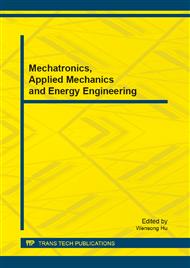p.448
p.456
p.463
p.470
p.477
p.482
p.487
p.495
p.499
Experimental Study on a Piezoelectric Energy Generator Excited by Rotating Magnets
Abstract:
To meet the demand of rotating mechanism for self-powered monitoring system, piezoelectric energy generator (PEG) excited by the magnetic coupling force between rotating magnets fixed on a rotator and those fixed on piezo-beam was presented. The influence of magnetic force (number and configuration of the magnets) and rotating speed on energy generation of the PEG was investigated experimentally. The research results show that there are several optimal rotating speeds for the PEG to achieve peak voltage at speed range of 0 to 1390r/min. Under a given number of magnets fixed on the end of the piezo-beam, the peak voltages rise with the increasing of rotating magnets number and rotating speed. At 636r/min, the achieved peek voltages from the PEG with 1/2/4 rotating magnets are 12.1/15.2/20.0V respectively. Besides, the configuration modes of rotating magnets and the fixed magnets (repulsion, attraction, or repulsion-attraction) exert great influence on the peak voltage and the relative optimal rotating speeds. Taking a PEG with 2 rotating magnets for example, the 4th peek voltages and the relative optimal rotating speeds for the PEG under exciting mode of repulsion/attraction//repulsion-attraction are 12.6/15.0/16.4 V and 552/528/492 r/min respectively.
Info:
Periodical:
Pages:
477-481
Citation:
Online since:
September 2013
Authors:
Keywords:
Price:
Сopyright:
© 2013 Trans Tech Publications Ltd. All Rights Reserved
Share:
Citation:


